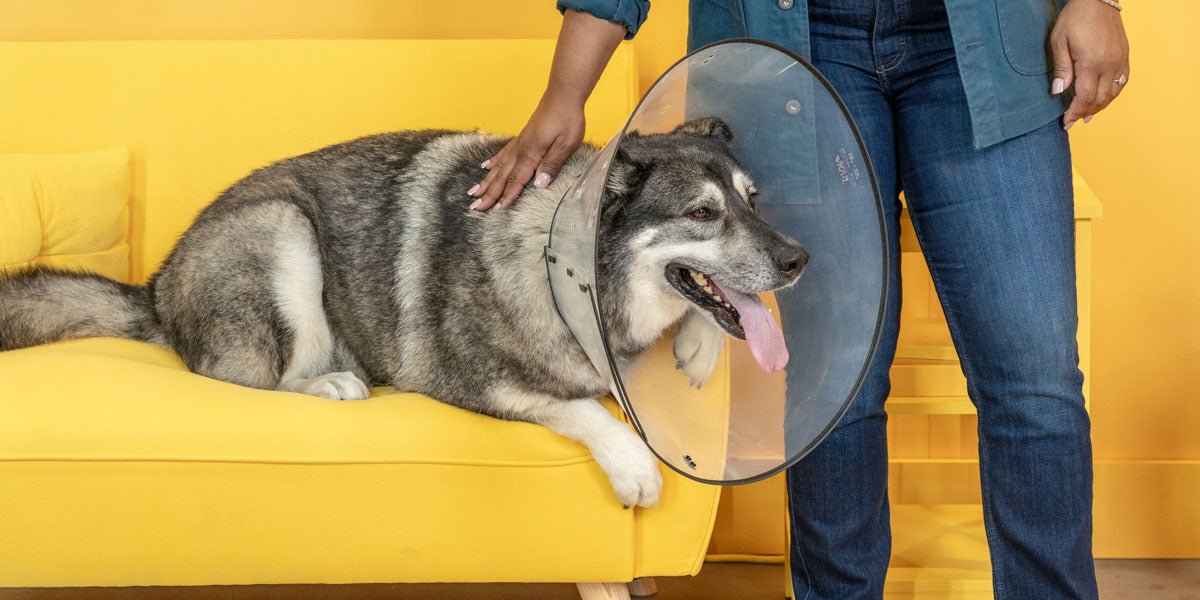
First-Time Tips for Helping Your Dog or Cat Adjust to an E-Collar
The first time your pet wears the “cone of shame” can feel a little dramatic, for everyone involved. Whether you’re dealing with a curious kitten, a nervous pup, or a grumpy senior pet, introducing an e-collar for the first time takes a bit of patience, planning, and compassion.
In this post, we’ll walk you through how to put on an e-collar (a.k.a. recovery cone) the right way, why some pets react with fear or resistance, and how to help your dog or cat adjust to their new “accessory” with as little stress as possible.
Why the Cone Can Be Scary
For your pet, wearing a cone is like suddenly having a strange, noisy object attached to their head; and they have no idea why. Common reasons for fear or resistance include:
- Restricted Vision: Traditional cones limit peripheral vision, which can feel disorienting.
- Unfamiliar Sensation: The cone may brush against walls, food bowls, or even their own legs.
- Movement & Sound: Plastic cones can rattle or scrape, adding to anxiety.
- Loss of Control: Pets may feel trapped or unable to interact normally with their environment.
These stress signals can show up as whining, freezing, pawing at the cone, or trying to shake or back out of it. But don’t worry; with the right strategies, most pets can adjust in just a day or two.
How to Put On an E-Collar for the First Time
Here’s a step-by-step approach for dogs and cats since they're both a little different:

For Dogs:
- Start Slow: Let your dog sniff and inspect the cone before putting it on. Offer treats for positive associations.
- Use the ID Collar Loops: The best e-collars (like those from KVP) have small loops that attach to your dog’s regular collar. This helps keep the cone secure and prevents slipping.
- Position the Cone Correctly: Slide it over the head so the wider opening is at the front, and the narrow end is toward the neck.
- Secure Snugly but Gently: Tighten the Velcro or weave strap until it’s secure but not choking -2 fingers should fit between the collar and the neck.
- Test the Fit: Make sure your dog can’t turn and lick their wound, but can still eat, drink, and rest comfortably.

For Cats:
- Wrap for Calmness: Try gently wrapping your cat in a towel burrito-style before placing the cone; this helps keep them still and reduces flailing.
- Quick & Calm: Cats prefer things done fast. Slip the cone over the head swiftly, then secure it with the collar.
- Watch for Backing Up: Some cats try to walk backwards to escape the cone. Redirect gently and give treats when they stop.
- Safe Space: Keep your cat in a smaller, quiet room for the first 30 minutes so they don’t get overwhelmed exploring with the cone.

Strategies to Reduce Cone Stress
1. Practice Before You Need It
If you know a surgery or treatment is coming, introduce the cone a few days in advance to desensitize your pet.
2. Try a Softer Option
Soft e-collars or inflatable alternatives (like the KVP Calmer™ or KONG™ Cloud) reduce noise and bulk, making adjustment easier.
3. Use Positive Reinforcement
Reward calm behavior with treats, petting, or play. Avoid punishment or panic if they resist at first.
4. Remove It Briefly (With Supervision)
Let your pet have short breaks from the cone while you supervise, especially during mealtime, to help ease frustration.
5. Modify Their Environment
Widen water bowls, raise dishes, and clear tight corners or furniture that might snag the cone.
Remember: The Cone Is Temporary—but Necessary
It’s hard to see your pet confused or stressed, but remember: the cone is a medical tool, not a punishment. It protects them from licking or scratching wounds, surgical sites, or hot spots that could lead to infection or longer recovery.
With calm guidance, the right fit, and a little love, your dog or cat will adjust, and their healing will be faster for it.
Need help picking the right cone or wondering which style your pet needs? Ask your veterinarian or check out trusted brands like KVP International, which offers both traditional and low-stress e-collars designed with healing and comfort in mind.